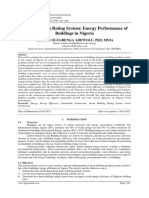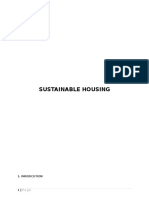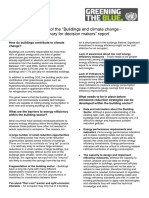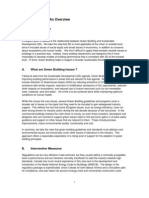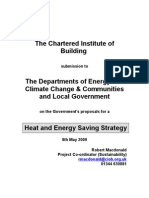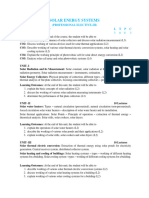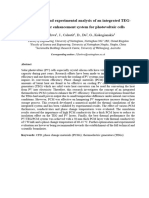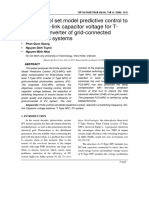Report y
Uploaded by
UsmanReport y
Uploaded by
UsmanIntroduction
India is currently facing challenges, in meeting its energy requirements. If India maintains a growth
rate of 8% per year its primary energy supply will need to increase by 3 to 4 times while electricity
generation capacity needs to grow by 5 to 6 times compared to the levels in 2003 04. By the year 2031
32 it is projected that the country will require a power generation capacity of 800,000 MW
considering both installed capacity and captive plants compared to the installed capacity of around
160,000 MW. Presently there is an estimated electricity shortage of about 9.9% and a peak demand
shortage of around 16.6%. The domestic and commercial sectors together contribute one third of
electricity consumption and are expected to consume approximately 37% of electricity by the year
2020 21.
The energy consumption in the building sector continues to rise because new buildings are being
constructed at a pace than older ones are being retired. Additionally per capita energy consumption
has increased in India due to improved living standards and advancements in energy usage, across
households and industries.
The Indian building industry is heavily influenced by the commercial sectors like the development of
Chicago. The plan is to construct 700 900 million meters of commercial space annually until 2030.
However buildings also contribute significantly to the emission of Green House Gases (GHG) posing
a risk. This is a concern emphasizing the need, for energy buildings that not only reduce GHG
emissions but also minimize energy consumption. Recent efforts have been made to enhance energy
efficiency in buildings, including the implementation of Indias Energy Conservation Building Codes
(ECBC) for buildings. Additionally the government intends to explore energy sources and promote
adoption of solar power. Electricity plays a role in providing services within buildings, such as
heating, cooling, lighting, water heating and powering electrical devices. By focusing on constructing
energy friendly and high performance buildings like NZEBs (nearly zero energy buildings) we can
pave the way, for long term solutions in managing our future energy consumption challenges.
India has gradually begun to incorporate energy efficiency solutions in its construction industry, as
well as by supporting green building market growth in India using popular green building certification
systems, using a variety of techniques and approaches. If this is to be effective, these activities must
be strengthened or scaled up to match the potential for energy savings in proportion to India's
exponential expansion in the building industry. As a result, India's construction sector need strong
policies and packages that address a wide range of issues related to energy efficiency improvement
and scalability, as well as the use of renewable technologies in both new and existing structures.
The worldwide effort to minimize CO2 emissions, the paucity of energy supplies, the reliance on
fossil fuels, and the fact that buildings consume a significant amount of the world's primary energy all
push research toward novel building designs, notably NZEBs. This idea has gained support in recent
years as a growing number of stakeholders throughout the world attempt to decrease energy
consumption, operational expenses, and energy footprints from their building portfolios. The
development and growth of NZEBs is the most recent and arguably most ambitious of these attempts.
NZEBs are commonly regarded as exceptionally energy-efficient buildings that use renewable energy
technology to generate the same amount of energy as they use in a year. As a result, the NZEB
approach used by each nation may differ.
The grid's resources for (green) power, as well as the infrastructure for heating and cooling, vary
depending on the environment. To meet the demands of building, a long-term energy strategy is
necessary. This has the potential to increase energy efficiency and use. Renewable energy resources
are those that can be harvested again and again. The major purpose is to develop new structures. by
applying energy-saving building strategies create energy-efficient buildings (NZEBs). Structures with
net-zero energy do not exist in a vacuum. Regardless of the many definitions of net-zero building.
The phrase "net-zero" means that there is no interface with an external energy grid.
Accounting for the chosen statistic (for example, primary energy) over a reasonably long period of
time (typically a year) results in a net balance close to zero. A NZEB's design typically requires the
successful integration and optimization of several architectural concepts and strategies, such as
building orientation in relation to the sun path, natural ventilation, solar shading, daylighting, solar
heat gains, thermal comfort, as well as the implementation of well-proven insulation practices,
energy-efficient glazing, air conditioning, and lighting systems, and the incorporation of renewable
energy technologies for on-site energy generation. Green buildings, also known as NZEBs, are not yet
common in India, but politicians, architects, and builders are increasingly recognizing and lobbying
for their advantages. The federal and state governments are aiming to include energy efficiency and
renewable energy into building design. NZEB site and industry alliance (i), NZEB demonstration
projects (ii), and Net Zero certification (iii) have all been implemented in India to encourage NZEB
market adoption.
Identification of critical components and challenges
The design and functioning of the Indira Pariavaran Bhawan, which focuses on promoting
sustainability and ecological responsibility involve important elements and hurdles. This examination
will explore these aspects in detail providing insights into factors that significantly contribute to the
projects achievements and efficacy. Through a report spanning 1500 words we will explore the
components and challenges associated with this renowned environmentally friendly structure.
1.sustinable design and materials
One crucial aspect of the project involves ensuring that sustainable design principles are applied and
friendly construction materials are chosen. This is essential not, for reducing the buildings impact on
the environment but for maximizing its long term operational efficiency. There are challenges
associated with this such, as;
Integration of Design; Achieving an integration of design elements like passive solar design, green
roofs and natural ventilation demands a great deal of expertise and coordination, between the design
and engineering teams.
Sourcing Materials; Locating and procuring construction materials can be quite demanding especially
when it comes to finding components that meet rigorous environmental standards.
Cost Considerations; It's important to note that some friendly materials and design features may
initially come with costs posing financial challenges for the project. Striking a balance, between
sustainability and budget limitations is crucial.
2. Environmental Clearances and Regulations:
Getting the approvals and following guidelines is a crucial aspect when it comes to prioritizing
environmental preservation in the project. There are challenges that need to be addressed in this
regard;
Strict Environmental Standards; Adhering to environmental standards and regulations might
necessitate adjustments, to the projects design or construction procedures, which could potentially
cause delays and additional expenses.
Opposition from Stakeholders; Environmental initiatives often encounter opposition from
stakeholders who may express concerns about negative impacts or question the necessity of the
project.
Monitoring and Reporting; Ensuring compliance, with regulations and reporting to relevant
authorities can be demanding in terms of time and resources.
3. Financing the Project;
Securing funding, for a project ambitious as the Indira Pariavaran Bhawan is crucial. There are
challenges to consider;
Sources of Funding; Relying on government funds grants and loans can be uncertain because changes
in politics or the economy can impact the availability of these resources.
Budget Management; Setting sustainability goals may result in increases in costs so it's important to
carefully handle project finances.
Return, on Investment; Demonstrating the long term value and cost savings associated with building
features might be difficult especially if these benefits are not immediately realized.
4. Engaging with Stakeholders;
Engaging with a range of stakeholders including government agencies, environmental organizations
and local communities is vital, for the success of the project. We encounter challenges in this process;
Addressing Diverse Interests; It can be quite complex to balance the interests and expectations of all
stakeholders since each group may have unique priorities and concerns.
Maintaining Positive Public Relations; To garner support and cooperation it is crucial to maintain a
image and effectively address any concerns or issues raised.
Involving the Local Community; Ensuring that the local community benefits from the project and
understands its significance remains a priority.
5. Implementing Construction Practices;
The implementation of construction practices is at the core of this project. While doing so we face
challenges;
Workforce; Ensuring that our construction workforce is well trained in building practices and safety
measures may require effort and investment.
Efficient Resource Management; Managing resources during construction. Such as reducing waste
generation and minimizing energy consumption. Presents its set of demands.
Project Timelines; The adoption of practices, like using recycled materials or sourcing locally may
lead to delays if not meticulously planned.
6. Energy Efficiency and Renewable Energy;
Achieving energy efficiency and incorporating energy sources are aspects of creating environmentally
conscious buildings. There are a challenges to consider;
Cutting Edge Technology; Implementing energy efficient technologies might require specialized skills
and knowledge.
Financial Investment; The initial cost of installing energy systems, like panels or wind turbines can be
significant. It may take some time to see the cost savings.
Maintenance and Performance Monitoring; Ensuring the long term effectiveness of energy systems
necessitates ongoing maintenance and monitoring which can be resource intensive.
7. Post Construction. Maintenance;
The long term success of the project relies on operation and maintenance. Here are some challenges to
address;
Sustainability Practices; Ensuring that sustainable practices such as waste reduction and energy
conservation are upheld during building operations may require training and monitoring.
Budget Allocation; Allocating a budget, for construction maintenance is crucial to prevent neglect and
deterioration of eco friendly systems.
Occupant Engagement; Encouraging building occupants to participate in practices can be a challenge
as it requires education and motivation.
8. Monitoring and Evaluation;
monitoring and evaluating the projects performance is crucial. There are challenges involved, such
as;
Collecting data, on energy consumption, water usage and other sustainability metrics can be a
complex and resource intensive task.
Comparing the buildings performance to established sustainability benchmarks and goals helps
identify areas that need improvement.
Continuously identifying areas, for improvement and implementing changes is a process that requires
dedication and resources.
DESIGN STRATEGY
The design of the Indira Paryavaran Bhawan comprises three design strategies. To develop the most
energy efficient building, a passive design strategy is used initially, followed by an active design
strategy, and eventually, a renewable energy system is used. All three design options were investigated
concurrently in order to provide the most effective and feasible environmentally friendly and energy
efficient building design.
2.1.1 PASSIVE DESIGN STRATEGY
All passive components of the structure, such as orientation, landscaping, day-lighting, ventilation,
building envelope, materials, and construction methods, were addressed during the design phase.
Solar Orientation and Building Layout;
One of the strategies, for designing the Indira Pariavaran Bhawan is to optimize its orientation and
building layout. The positioning of the building cleverly makes use of daylight while minimizing the
amount of heat from sunlight.
Southern Facade; The southern side of the building has windows and openings which allow the gentle
winter sunlight to brighten up the spaces. This not brings in light but also helps keep it warm during
colder months.
Northern Facade; On the hand the northern side of the building is designed with windows and shading
elements ensuring that direct sunlight and excessive heat are minimized during summers keeping
indoor areas cooler.
West Orientation; Special attention has been given to managing heat gain from east and west
directions where it can be intense. To tackle this shading devices like fins and louvers are used to
block sunlight.
Central Courtyard; The central courtyard within the building layout acts as a light well allowing
natural light to reach into the core of the structure. This reduces dependence, on lighting.
2. Shading and Overhangs;
Having shading and overhangs is essential, for creating an indoor atmosphere and reducing the impact
of solar heat. The Indira Pariavaran Bhawan incorporates shading techniques to achieve this goal.
The building incorporates fixed awnings, on its side. These awnings extend beyond the windows to
shield them from the summer sun while still allowing natural light to brighten the interior during
winter months.
For the western facades dynamic shading devices are installed. These devices, such, as motorized
louvers and sunscreens automatically adjust their position based on the angle of the sun. This real time
response optimizes light while also minimizing glare and heat buildup.
In addition vertical fins are incorporated into the buildings design. These fins provide shade by
reducing sunlight and also add an appealing architectural element to the overall aesthetic.
3.Natural Ventilation:
The Indira Pariavaran Bhawan incorporates design strategies to reduce its reliance, on cooling
systems. Here are some key features;
1. Cross Ventilation; The buildings layout is carefully planned to encourage the flow of air. We've
strategically placed windows and vents that can be opened to let in a breeze.
2. Stack Effect; Inside there's an atrium that acts like a chimney helping with natural ventilation. As
warm air rises within the atrium it creates a vacuum effect drawing in air from outside through placed
openings and vents.
3. Night Purge Cooling; To take advantage of conditions during the night our building is equipped
with a cooling system that flushes out warm air and replaces it with cooler nighttime air.
By incorporating these strategies we aim to create a comfortable environment inside the Indira
Pariavaran Bhawan while reducing our reliance, on mechanical cooling systems.
4. Thermal Mass:
Thermal mass plays a role, in storing and distributing heat, which in turn helps to maintain optimal
indoor temperatures. At the Indira Pariavaran Bhawan various strategies are implemented to make the
most of mass.
Exposed concrete floors have been incorporated in parts of the building to effectively absorb and
retain heat throughout the day gradually releasing it at night. This smart design feature greatly
contributes to maintaining temperatures.
Additionally the presence of high quality insulation, in the walls and roofs plays a role in preserving
the mass by minimizing heat transfer, between the inside and outside environments.
5. Energy-Efficeent glazing:
Choosing energy glazing is a strategy, for passive design. It involves finding the balance between
allowing light in and controlling heat gain.
One way to achieve this is by applying performance, emissivity (Low E) coatings on the glazing.
These coatings reduce heat transfer while still allowing visible light to pass through.
Another option is to use glazed windows with a layer of gas in, between the panes. This setup
provides insulation.
Lastly selective glazing can be used to minimize the transmission of solar radiation. By doing it helps
reduce heat gain while still allowing visible light to enter.
6. Roof Design and Green Roof:
The design of the roof plays a role, in design because it has a direct impact, on the amount of heat
gained and energy consumed. The Indira Pariavaran Bhawan incorporates the following elements;
Reflective Roof; We use a material that reflects sunlight and stays cool to minimize heat absorption
and reduce the amount of heat gained.
Vegetated Roof; A portion of the roof is dedicated to a space covered with plants, which not provides
insulation but also helps enhance thermal comfort and decrease stormwater runoff.
7. Daylight Harvesting:
Maximizing the amount of sunlight is an aspect of passive design. The building incorporates strategies
to harvest daylight, including the use of light shelves. These shelves are cleverly integrated into the
design allowing them to reflect and redirect sunlight deeper into the spaces.
8. Thermal Comfort and Insulation:
The Indira Pariavaran Bhawan prioritizes occupant comfort through comprehensive insulation and
thermal comfort strategies:
High-Performance Insulation: Building envelopes are well-insulated, reducing heat transfer and
enhancing energy efficiency.
Natural Ventilation:* The design allows for operable windows and vents in most spaces, giving
occupants control over their thermal comfort and indoor air quality.
9. Sustainable landscaping
The surrounding landscape is crucial in passive design, contributing to the building's microclimate
and aesthetics:
Native Plants:* Using native plants in landscaping saves water while also promoting local
biodiversity.
Shade Trees:* Strategically positioned shade trees around the building provide natural cooling and
contribute to the reduction of the urban heat island effect.
10. Monitoring and Optimization:
Ongoing monitoring and optimization of building systems and strategies are crucial, in design;
The Indira Pariavaran Bhawan has a Building Management System (BMS) that constantly monitors
indoor conditions and makes adjustments to passive systems accordingly.We encourage occupants to
engage in design strategies by controlling operable windows and shades which not only enhances
their own comfort but also reduces energy consumption.
In summary the Indira Pariavaran Bhawan exemplifies an skillfully executed incorporation of design
techniques. The buildings sustainability, energy efficiency and occupant well being are enhanced by
considerations such, as orientation, shading strategies, natural ventilation, thermal mass utilization,
energy efficient windows, roof design, daylight optimization, thermal comfort provisions and eco
friendly landscaping. This approach not aligns with the projects objectives but also sets an example,
for sustainable architecture and construction practices.
ACTIVE DESIGN STRATOGY
The Indira Pariavaran Bhawan is a shining example of environmentally friendly architecture and
design. While passive design approaches help to reduce energy consumption and maximize natural
resources, active design strategies promote building sustainability and occupant comfort by using
current technologies and systems.
1. Energy-Efficient HVAC Systems:
An important factor, in the design of the Indira Pariavaran Bhawan is the incorporation of energy
saving HVAC (Heating, Ventilation and Air Conditioning) systems. These systems play a role, in
creating an indoor environment while also minimizing energy usage. Some key components include;
Advanced Controls: Smart building management systems regulate HVAC operations, considering
factors such as outdoor weather conditions and occupancy, to optimize energy use and indoor comfort.
Occupancy Sensors: Sensors detect occupancy and adjust HVAC settings in real-time, minimizing
energy consumption in unoccupied areas.
Heat Recovery Ventilation; Energy recovery ventilators help to improve the quality of air while saving
energy by capturing and transferring heat, between outgoing air streams.
Energy Efficient Chillers; Utilizing high efficiency chillers, for cooling purposes not ensures comfort.
Also contributes to energy conservation resulting in substantial savings.
Variable Refrigerant Flow (VRF) Systems: VRF systems allow for precise control over heating and
cooling in different zones of the building, reducing energy waste by delivering only the necessary
amount of conditioned air.
2. Daylighting and Lighting Control:
The Indira Pariavaran Bhawan utilizes design methods to maximize lighting and optimize lighting
control thereby minimizing the reliance, on artificial lighting and improving the comfort of occupants.
Notable aspects include;
Automated Shading: Motorized shading devices respond to changing solar angles and external light
levels to optimize daylight penetration while reducing glare and solar heat gain.
Occupancy Sensors: Motion sensors detect occupancy and adjust lighting levels, ensuring that lights
are on only when needed, minimizing energy waste.
Daylight Harvesting: Daylight harvesting systems work in tandem with lighting controls to maximize
natural light use, automatically dimming or turning off electric lights when sufficient daylight is
available.
Tunable Lighting: Tunable LED lighting systems provide flexibility in adjusting light color
temperature to create various lighting moods and support occupant well-being.
3. Renewable Energy Integration:
At the Indira Pariavaran Bhawan we are actively committed, to embracing energy sources as a means
to reduce our dependency, on power grids. Our main focus lies in harnessing energy.
The building has panels, on its roof that capture sunlight and convert it into electricity. This renewable
energy source helps lower both the buildings energy costs and its impact on the environment.
To guarantee a supply of power the building utilizes energy storage systems, like batteries to store any
solar energy for use when there is no direct sunlight available.
If the solar panels generate electricity than needed the excess power can be sent back, to the grid. This
allows for energy credits. Further decreases the buildings expenses related to energy consumption.
4. Advanced Building Envelope:
The building envelope is enhanced with active design strategies to create an efficient thermal barrier
and protect against temperature extremes:
High-Performance Insulation: Well-insulated walls and roofs minimize heat transfer, ensuring that the
building remains thermally efficient.
Thermal Barrier Materials: The use of materials with low thermal conductivity, such as insulated
concrete panels and advanced glazing, enhances the building's thermal performance.
Dynamic Glazing: Electrochromic or smart glass technology is employed in certain areas to allow for
real-time control of window tint, reducing solar heat gain and glare.
5. Water efficiency and management
In order to reduce water consumption and minimize waste it is important to implement strategies, for
water efficiency and management;
1. Installing low flow fixtures such as faucets, showers and toilets can help conserve water without
compromising performance.
2. Incorporating rainwater harvesting systems in buildings allows for the collection and storage of
rainwater. This collected water can then be used for landscape irrigation and non potable purposes.
3. Treating and recycling graywater from sinks and showers is another approach. By using treated
graywater to flush toilets the demand, for freshwater is further reduced.
4. Equipping the landscape with an irrigation system that adjusts water delivery based on weather
conditions and soil moisture levels helps prevent overwatering.
By implementing these design strategies we can significantly contribute to reducing water
consumption and waste management.
6. Waste Management and Recycling:
Efficient waste management and recycling techniques are actively integrated into the building's design
and operation:
The building comes with a waste separation system that promotes the practice of sorting recyclables,
compostable materials and general waste, from where it originates.
We practice on site composting to reduce the amount of waste we send to landfills. This process also
allows us to create high quality compost, for our landscaping needs.
To promote sustainability we make sure to use recycled materials in both the construction and interior
design of our building. This includes incorporating glass, steel and wood into aspects of the project
7. Smart Building Technologies:
Building economy, security, and tenant comfort can all be improved using smart building technology:
Building Automation System (BAS); The BAS is designed to centralize control over building systems
such, as HVAC, lighting and security. Its main purpose is to optimize the performance of these
systems.
Occupant Interface; Occupants have the ability to interact with the buildings systems through user
interfaces. These interfaces allow them to personalize settings according to their preferences and
report any issues they may encounter.
Energy Monitoring; Real time energy monitoring systems provide occupants with information about
their energy consumption patterns. This empowers them to make decisions regarding their energy use
and adopt sustainable practices.
Security and Access Control; security and access control systems enhance both safety and
convenience within a building. They enable entry and exit while maintaining security measures, for
the overall protection of occupants and assets..
8. Indoor Air Quality (IAQ) Management:
Active design solutions are utilized to ensure a healthy interior environment and excellent indoor air
quality:
High-Efficiency Filtration: Advanced air filtration systems remove particulate matter, allergens, and
pollutants, ensuring the provision of clean indoor air.
Ventilation Control: The building features demand-controlled ventilation, adjusting the rate of fresh
air supply based on occupancy and indoor air quality.
IAQ Sensors: Indoor air quality sensors continually monitor and provide feedback on IAQ
parameters, allowing for real-time adjustments as needed.
9. Sustainable Transportation Infrastructure:
The building actively promotes sustainable transportation options for occupants and visitors:
Bicycle Facilities: To encourage cycling as a means of transportation, enough bicycle storage,
showers, and changing facilities are provided.
Access to Public transit: The building's location was chosen to provide for convenient access to public
transit, decreasing dependency on individual automobiles.
10. Occupant Engagement and Education:
Active design strategies include educational initiatives and occupant engagement programs to raise
awareness and encourage sustainable behavior:
Sustainability Workshops: The Indira Pariavaran Bhawan organizes workshops and events focused on
sustainability to educate the occupants, about the features and practices that promote sustainability
within the building.
Communication Platforms: There is a platform that offers information and resources related to
sustainability. It provides tips on conserving energy and reducing waste.
Occupant Feedback: To ensure efforts towards sustainability, regular surveys and feedback
mechanisms are, in place. Occupants can share their opinions suggest improvements and actively
contribute towards achieving goals.
Challenges and critical components
1. Critical Components:
Passive Design Techniques;
Utilizing Natural Ventilation; The structure incorporates windows and vents that can be opened and
closed, allowing for the circulation of air and reducing reliance, on cooling systems.
Harnessing Daylight; Carefully positioned windows and skylights are incorporated to optimize light
penetration thus minimizing the need for artificial lighting.
Utilizing Thermal Mass; The building utilizes materials such, as concrete to absorb and gradually
release heat promoting indoor temperatures.
Green Roof:
The rooftop features a green roof system that includes a layer of vegetation, providing insulation,
managing stormwater, and promoting biodiversity.
This green roof reduces heat gain, improves air quality, and serves as an eco-friendly space for
occupants.
Solar Photovoltaic Panels:
The buildings rooftop solar panels harness the power of sunlight. Produce electricity, which helps
meet its energy requirements.
This renewable energy source, on site decreases the buildings dependence on fuels and minimizes its
impact, on the environment by reducing carbon emissions.
Rainwater Harvesting:
The building incorporates rainwater harvesting systems to collect and store rainwater for non-potable
uses and landscape irrigation.
This reduces the demand for freshwater and minimizes the strain on local water resources.
Energy-Efficient HVAC Systems:
Variable Refrigerant Flow (VRF) systems provide precise control over heating and cooling in
different zones, optimizing energy use and comfort.
Heat recovery ventilation systems exchange heat between incoming and outgoing air, improving
indoor air quality while conserving energy.
Advanced Building Management System (BMS):
The BMS continually monitors indoor conditions, adjusting passive systems such as lighting, shading,
and HVAC based on occupancy and external factors.
It ensures optimal performance, energy efficiency, and occupant comfort.
Solar Control and Shading Devices:
The building incorporates shading systems that regulate the amount of sunlight and glare improving
the comfort of those inside and minimizing the reliance, on lighting and cooling.
2. Challenges:
Initial Costs:
The integration of sustainable features, such as green roofs, solar panels, and high-efficiency systems,
can result in higher upfront costs.
Convincing stakeholders to invest in these features while considering long-term cost savings and
environmental benefits is a challenge
Complex Building Envelope:
The building's envelope, with its dynamic glazing and advanced insulation, can be technically
challenging to design, construct, and maintain.
Coordinating these components to ensure seamless integration and optimal performance is a complex
task.
Regulatory Compliance:
Meeting stringent environmental and safety regulations, including emission standards and
construction waste management, is a complex task.
Ensuring compliance with local building codes and regulations can require meticulous planning and
coordination.
Complex Building Envelope:
Managing a complex building envelope, including dynamic glazing and advanced insulation, can be
challenging.
Coordinating these elements to optimize energy efficiency and occupant comfort while ensuring
seamless integration requires technical expertise.
Grid Integration:
Coordinating the building's energy generation and consumption with the local grid can be complex,
particularly in regions with variable grid quality.
Ensuring the seamless integration of renewable energy sources with the grid can be technically
challenging.
Storage Costs:
Battery storage solutions for renewable energy can be expensive, and managing the costs while
ensuring adequate storage capacity is a challenge.
Balancing the need for energy storage with budget constraints can be complex.
Integration of Green Technologies:
Incorporating renewable energy sources like solar panels and green roofing systems requires careful
planning, technical expertise, and ongoing maintenance.
Overcoming technical challenges and ensuring the optimal functioning of these systems is vital.
Lessons Learned
The Indira Pariavaran Bhawans strong dedication, to sustainability and environmental responsibility
shows that it is feasible to create and build structures that have an impact on the environment.
The project emphasizes the significance of adopting a design approach taking into account all aspects
of a buildings lifespan from its construction, to its operation.
Passive Design Strategies; The effectiveness of using ventilation daylight harvesting and green roofs,
in buildings demonstrates that simple nature inspired solutions can greatly reduce energy
consumption.
Integration of Renewable Energy; By incorporating photovoltaic panels and efficient HVAC systems
we can show that it is possible to decrease a buildings reliance on fuels through renewable energy
integration.
Building Management System (BMS); The use of an advanced BMS highlights the importance of
time monitoring and control systems in optimizing energy usage and ensuring occupant comfort.
Involving Occupants; Encouraging building occupants to engage in practices, such as controlling
windows and conserving energy is vital for maximizing the advantages of sustainable design.
Complex Building Envelope; Although complex building envelopes pose challenges they can
significantly improve energy efficiency and comfort when designed and maintained properly.
Meeting Regulatory Standards; Adhering to safety regulations is crucial. It requires planning and
coordination to ensure compliance with these standards.
Education and Training; Investing in education and training programs for maintenance staff as
building occupants is essential, for the effective operation and maintenance of sustainable systems.
Recommendations:
The Indira Pariavaran Bhawans design and sustainable features can serve as a model, for construction
projects not only in India but globally as well. The principles of sustainability, passive design and the
integration of energy can be applied to types of buildings and regions.
Public Education: Educating the public about the benefits of sustainable building and design is vital.
Indira Pariavaran Bhawan might be used as a case study to raise awareness of the environmental and
quality of life advantages of sustainable construction methods.
Governments and municipalities can provide incentives and guidelines to encourage the incorporation
of sustainable components into construction projects. Tax rebates, expedited permits, and other
incentives can all be used to encourage the use of ecologically friendly building practices.
Training Programs: Training programs for construction professionals, architects, engineers, and
building operators can be established to promote competence in sustainable design and operation.
This will ensure that future developments incorporate sustainable aspects in an effective manner.
Ongoing research and development, in building materials and technologies play a role in driving
innovations that can enhance the efficiency and sustainability of future construction projects.
Conducting a occupancy evaluation of Indira Pariavaran Bhawan can provide valuable insights into its
actual performance and areas that can be improved. This valuable data can then inform the design and
construction of buildings.
Promoting design and construction requires efforts between government agencies, private sectors and
environmental organizations. By joining forces through partnerships we can undertake more
ambitious projects with significant sustainability impacts.
It is essential to adapt features to suit the climatic and environmental conditions of each region where
a building is located. What works well in New Delhi may not be applicable to climates so designs
should be tailored accordingly.
To ensure term optimal performance, operation, maintenance plans and regular monitoring of systems
should be integrated into the design of sustainable buildings. Building management teams must
receive training to ensure systems function optimally over time.
When considering the costs of implementing features it is crucial to conduct a long term cost analysis.
Sustainable practices often result in costs over time while providing higher returns, on investment.
You might also like
- Case Study Indias First Net Zero Energy Building Indira Paryavaran BhavanNo ratings yetCase Study Indias First Net Zero Energy Building Indira Paryavaran Bhavan5 pages
- Chapter 1: Introduction: 1.1 Overview of The ProjectNo ratings yetChapter 1: Introduction: 1.1 Overview of The Project4 pages
- Green and Energy Efficient Buildings - : Case Study of Bangalore & MysoreNo ratings yetGreen and Energy Efficient Buildings - : Case Study of Bangalore & Mysore47 pages
- Green and Smart Buildings - Jadhav, N.Y PDF100% (1)Green and Smart Buildings - Jadhav, N.Y PDF7 pages
- Manipal School of Architecture and Planning: Subject: Green Buildings First Semester-Mdes - 2021No ratings yetManipal School of Architecture and Planning: Subject: Green Buildings First Semester-Mdes - 20219 pages
- Designing A Questionnaire For A Research Paper A Comprehensive Guide To Design and Develop An Effective QuestionnaireNo ratings yetDesigning A Questionnaire For A Research Paper A Comprehensive Guide To Design and Develop An Effective Questionnaire16 pages
- Dissertation On The Code For Sustainable Homes100% (2)Dissertation On The Code For Sustainable Homes8 pages
- Green Building Rating System: Energy Performance of Buildings in NigeriaNo ratings yetGreen Building Rating System: Energy Performance of Buildings in Nigeria8 pages
- The Green Building Blueprint Strategies For Eco-Friendly ConstructionNo ratings yetThe Green Building Blueprint Strategies For Eco-Friendly Construction80 pages
- Passive Retrofit Strategies As An Intervention in Building Efficiency in Winter Season 1 1No ratings yetPassive Retrofit Strategies As An Intervention in Building Efficiency in Winter Season 1 116 pages
- Slidesgo Achieving Sustainability The Principles and Practices of Zero Energy Buildings 20240919044054OjwQNo ratings yetSlidesgo Achieving Sustainability The Principles and Practices of Zero Energy Buildings 20240919044054OjwQ13 pages
- ASS-4 Green Building in The PhilippinesNo ratings yetASS-4 Green Building in The Philippines11 pages
- A Summary of The "Buildings and Climate Change - Summary For Decision Makers " ReportNo ratings yetA Summary of The "Buildings and Climate Change - Summary For Decision Makers " Report4 pages
- EAA 2480 Project Design 1 - Proposal Template (1) IRUNGU JOE LEWIS.No ratings yetEAA 2480 Project Design 1 - Proposal Template (1) IRUNGU JOE LEWIS.14 pages
- ‘EIC analysis of renewable energy sectorTATA POWER’ atNo ratings yet‘EIC analysis of renewable energy sectorTATA POWER’ at9 pages
- Green and Energy Efficient Buildings: Challenges and SolutionsNo ratings yetGreen and Energy Efficient Buildings: Challenges and Solutions8 pages
- Green Building: Initiative Taken by BEE To Implement Green Building in IndiaNo ratings yetGreen Building: Initiative Taken by BEE To Implement Green Building in India10 pages
- 7 Evaluation of Building Regulations in Nigeria As Regards Energy EfficiencyNo ratings yet7 Evaluation of Building Regulations in Nigeria As Regards Energy Efficiency15 pages
- Green Retrofitting of Educational ComplexNo ratings yetGreen Retrofitting of Educational Complex12 pages
- Pages 1-24 From Green Building and LEED Core Concepts GuideNo ratings yetPages 1-24 From Green Building and LEED Core Concepts Guide24 pages
- Seminar Report on Green Construction Schemes for Minor ProjectsNo ratings yetSeminar Report on Green Construction Schemes for Minor Projects11 pages
- CIOB Response Heat and Energy Saving Strategy ConsultationNo ratings yetCIOB Response Heat and Energy Saving Strategy Consultation6 pages
- Energy Conservation and Commercialization (ECO-III)No ratings yetEnergy Conservation and Commercialization (ECO-III)11 pages
- 2.eng - A Path Towards Net Zero Energy BuildingsNo ratings yet2.eng - A Path Towards Net Zero Energy Buildings10 pages
- Literature Review On Energy Efficient Buildings100% (2)Literature Review On Energy Efficient Buildings8 pages
- Zero-Energy Building and Energy EfficienceNo ratings yetZero-Energy Building and Energy Efficience23 pages
- 7-Deloitte-Insights-2024-engineering-and-construction-industry-outlookNo ratings yet7-Deloitte-Insights-2024-engineering-and-construction-industry-outlook27 pages
- Building a Strong Foundation: Pioneering Advances in Architecture and Civil Engineering for the Future (Foundations for the Future: Advances in architecture and civil engineering 2)From EverandBuilding a Strong Foundation: Pioneering Advances in Architecture and Civil Engineering for the Future (Foundations for the Future: Advances in architecture and civil engineering 2)No ratings yet
- Engineering a Self-Sufficient Future: Strategies for Energy Independence in the United StatesFrom EverandEngineering a Self-Sufficient Future: Strategies for Energy Independence in the United StatesNo ratings yet
- 1.5 DEWA Training - PV Modules - Part 2 - AmmarNo ratings yet1.5 DEWA Training - PV Modules - Part 2 - Ammar31 pages
- Section 1204 Solar Photovoltaic Power Systems CALIFORNIA FIRE CODE 2019No ratings yetSection 1204 Solar Photovoltaic Power Systems CALIFORNIA FIRE CODE 20195 pages
- Module-1-Introduction To ME-Prashant Mulge NotesNo ratings yetModule-1-Introduction To ME-Prashant Mulge Notes21 pages
- Operating Manual SUNNY BOY 3000TL / 3600TL / 4000TL / 5000TLNo ratings yetOperating Manual SUNNY BOY 3000TL / 3600TL / 4000TL / 5000TL68 pages
- Power Plant Controller-Putting The Power Back Into The Hands of The DeveloperNo ratings yetPower Plant Controller-Putting The Power Back Into The Hands of The Developer6 pages
- Impact of On-Grid Solar Energy Generation System On Low Voltage Ride Through CapabilityNo ratings yetImpact of On-Grid Solar Energy Generation System On Low Voltage Ride Through Capability12 pages
- Appendix 1 - Malaysia ST (EC) Guidelines - For - Solar - Photovoltaic - Installation - On - Net - Energy - Metering - Scheme PDFNo ratings yetAppendix 1 - Malaysia ST (EC) Guidelines - For - Solar - Photovoltaic - Installation - On - Net - Energy - Metering - Scheme PDF231 pages
- A Dynamic Operational Scheme For Residential PV Smart InvertersNo ratings yetA Dynamic Operational Scheme For Residential PV Smart Inverters10 pages
- Finite Control Set Model Predictive Control To Balance DC Link Capacitor VoltageNo ratings yetFinite Control Set Model Predictive Control To Balance DC Link Capacitor Voltage13 pages
- CHAP 1, Lecture 1-A Fundamental's of Power SystemNo ratings yetCHAP 1, Lecture 1-A Fundamental's of Power System54 pages
- Download Full Solar heating and cooling systems Ioan Sarbu PDF All Chapters100% (8)Download Full Solar heating and cooling systems Ioan Sarbu PDF All Chapters64 pages
- Powerwall 2 AC Installation Manual: With Backup Gateway100% (1)Powerwall 2 AC Installation Manual: With Backup Gateway48 pages
- Case Study Indias First Net Zero Energy Building Indira Paryavaran BhavanCase Study Indias First Net Zero Energy Building Indira Paryavaran Bhavan
- Chapter 1: Introduction: 1.1 Overview of The ProjectChapter 1: Introduction: 1.1 Overview of The Project
- Green and Energy Efficient Buildings - : Case Study of Bangalore & MysoreGreen and Energy Efficient Buildings - : Case Study of Bangalore & Mysore
- Manipal School of Architecture and Planning: Subject: Green Buildings First Semester-Mdes - 2021Manipal School of Architecture and Planning: Subject: Green Buildings First Semester-Mdes - 2021
- Designing A Questionnaire For A Research Paper A Comprehensive Guide To Design and Develop An Effective QuestionnaireDesigning A Questionnaire For A Research Paper A Comprehensive Guide To Design and Develop An Effective Questionnaire
- Green Building Rating System: Energy Performance of Buildings in NigeriaGreen Building Rating System: Energy Performance of Buildings in Nigeria
- The Green Building Blueprint Strategies For Eco-Friendly ConstructionThe Green Building Blueprint Strategies For Eco-Friendly Construction
- Passive Retrofit Strategies As An Intervention in Building Efficiency in Winter Season 1 1Passive Retrofit Strategies As An Intervention in Building Efficiency in Winter Season 1 1
- Slidesgo Achieving Sustainability The Principles and Practices of Zero Energy Buildings 20240919044054OjwQSlidesgo Achieving Sustainability The Principles and Practices of Zero Energy Buildings 20240919044054OjwQ
- A Summary of The "Buildings and Climate Change - Summary For Decision Makers " ReportA Summary of The "Buildings and Climate Change - Summary For Decision Makers " Report
- EAA 2480 Project Design 1 - Proposal Template (1) IRUNGU JOE LEWIS.EAA 2480 Project Design 1 - Proposal Template (1) IRUNGU JOE LEWIS.
- ‘EIC analysis of renewable energy sectorTATA POWER’ at‘EIC analysis of renewable energy sectorTATA POWER’ at
- Green and Energy Efficient Buildings: Challenges and SolutionsGreen and Energy Efficient Buildings: Challenges and Solutions
- Green Building: Initiative Taken by BEE To Implement Green Building in IndiaGreen Building: Initiative Taken by BEE To Implement Green Building in India
- 7 Evaluation of Building Regulations in Nigeria As Regards Energy Efficiency7 Evaluation of Building Regulations in Nigeria As Regards Energy Efficiency
- Pages 1-24 From Green Building and LEED Core Concepts GuidePages 1-24 From Green Building and LEED Core Concepts Guide
- Seminar Report on Green Construction Schemes for Minor ProjectsSeminar Report on Green Construction Schemes for Minor Projects
- CIOB Response Heat and Energy Saving Strategy ConsultationCIOB Response Heat and Energy Saving Strategy Consultation
- Energy Conservation and Commercialization (ECO-III)Energy Conservation and Commercialization (ECO-III)
- 7-Deloitte-Insights-2024-engineering-and-construction-industry-outlook7-Deloitte-Insights-2024-engineering-and-construction-industry-outlook
- Building a Strong Foundation: Pioneering Advances in Architecture and Civil Engineering for the Future (Foundations for the Future: Advances in architecture and civil engineering 2)From EverandBuilding a Strong Foundation: Pioneering Advances in Architecture and Civil Engineering for the Future (Foundations for the Future: Advances in architecture and civil engineering 2)
- Engineering a Self-Sufficient Future: Strategies for Energy Independence in the United StatesFrom EverandEngineering a Self-Sufficient Future: Strategies for Energy Independence in the United States
- Section 1204 Solar Photovoltaic Power Systems CALIFORNIA FIRE CODE 2019Section 1204 Solar Photovoltaic Power Systems CALIFORNIA FIRE CODE 2019
- Operating Manual SUNNY BOY 3000TL / 3600TL / 4000TL / 5000TLOperating Manual SUNNY BOY 3000TL / 3600TL / 4000TL / 5000TL
- Power Plant Controller-Putting The Power Back Into The Hands of The DeveloperPower Plant Controller-Putting The Power Back Into The Hands of The Developer
- Impact of On-Grid Solar Energy Generation System On Low Voltage Ride Through CapabilityImpact of On-Grid Solar Energy Generation System On Low Voltage Ride Through Capability
- Appendix 1 - Malaysia ST (EC) Guidelines - For - Solar - Photovoltaic - Installation - On - Net - Energy - Metering - Scheme PDFAppendix 1 - Malaysia ST (EC) Guidelines - For - Solar - Photovoltaic - Installation - On - Net - Energy - Metering - Scheme PDF
- A Dynamic Operational Scheme For Residential PV Smart InvertersA Dynamic Operational Scheme For Residential PV Smart Inverters
- Finite Control Set Model Predictive Control To Balance DC Link Capacitor VoltageFinite Control Set Model Predictive Control To Balance DC Link Capacitor Voltage
- Download Full Solar heating and cooling systems Ioan Sarbu PDF All ChaptersDownload Full Solar heating and cooling systems Ioan Sarbu PDF All Chapters
- Powerwall 2 AC Installation Manual: With Backup GatewayPowerwall 2 AC Installation Manual: With Backup Gateway





















